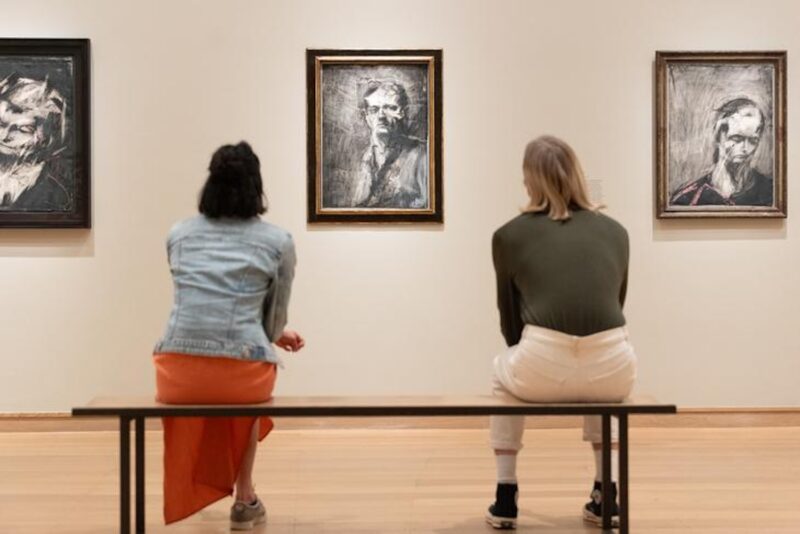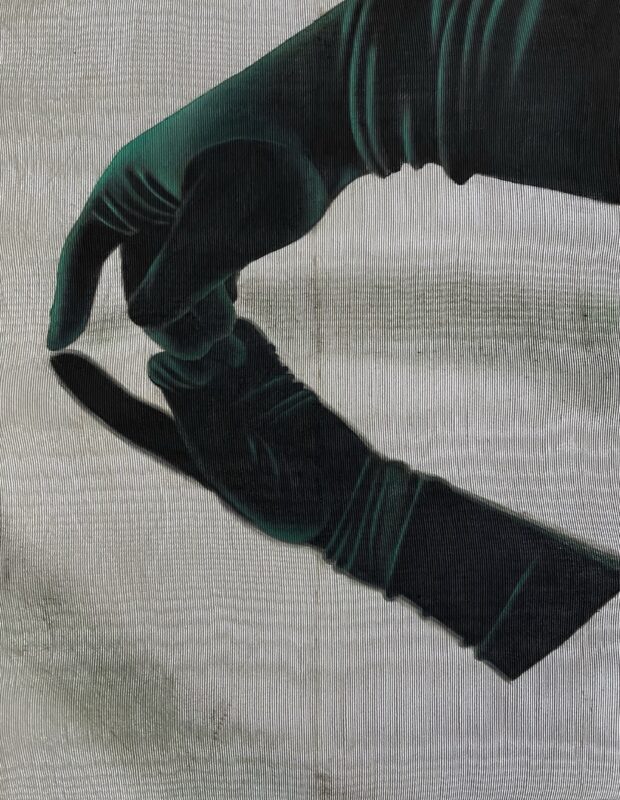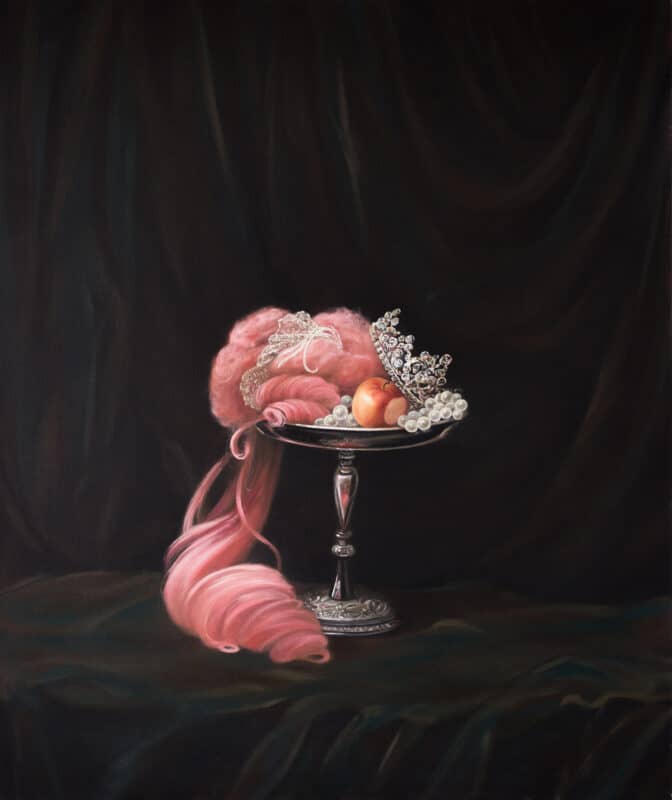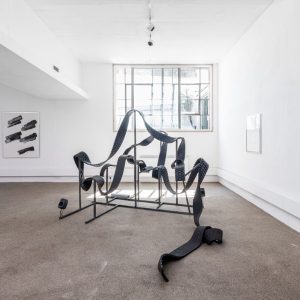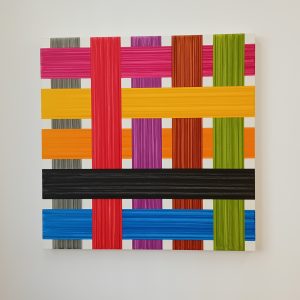
Rafaela de Ascanio’s work feels as if it is from another world. Her practice spans sculpture, painting and installation, forming an interdisciplinary mythos of its own. Informed by science fiction, heroic female protagonists in literature, folk law and esoteric pagan practices, her pieces have an archaeological aura. They almost appear as votive objects unexpectedly uncovered from the depths. Despite contemporary colour palates, largely informed by growing up in the tropical volcanic Canary Islands, the sculptures in particular, have an irreducible timeless quality.
Ascanio explores the female experience through iconographical symbols and diverse references throughout her practice, with each element working in tandem towards building an image of woman as empowered, heroic, self-sufficient, and resilient. Her sculptures bear the marks of the maker’s hand, creating an intimacy between the artist, the work and the viewer, and connecting us to the grounded yet spiritual notion of femininity central to the overall approach.
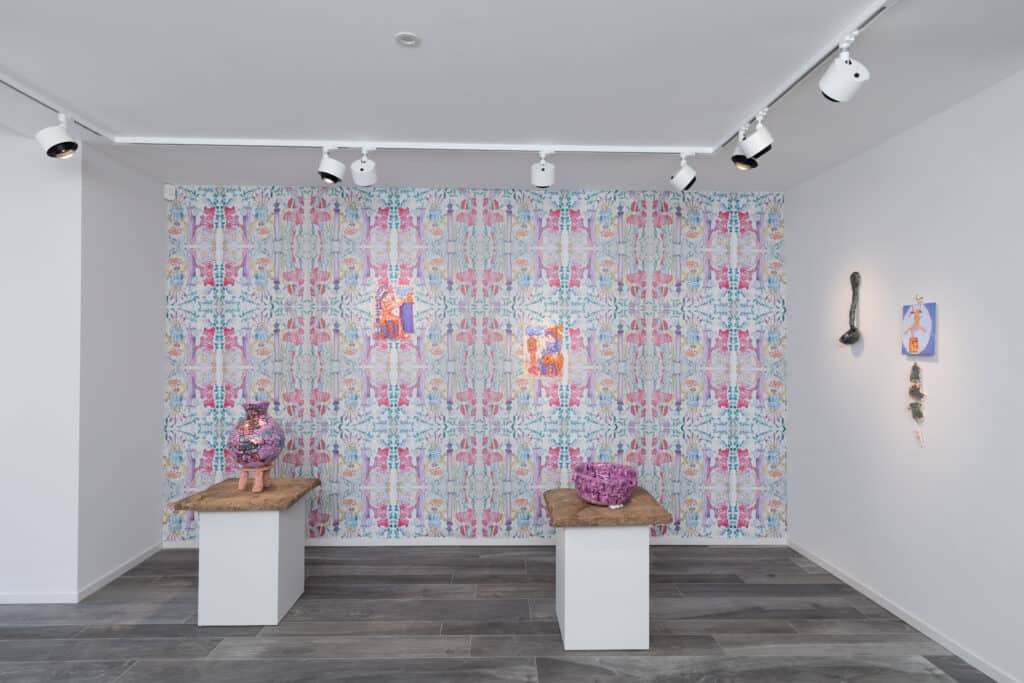
Currently on show as part of FANCY A BITE? at Studio West, Rafaela de Ascanio has created an installation suggestive of an altarpiece or location of worship. The handmade wallpaper that surrounds the space features the goddess Inanna, meanwhile, the sculptural pots contain delicate textile hands concealing a translucent baby’s foot. As a mother herself, Ascanio looks to the narrative of caregiving and the role of mothers as providers of sustenance for their children with her works on show. A small wall-mounted canvas depicting a trapeze artist is adorned with hanging ceramic items evoking child-rearing paraphernalia and alluding to the juggling act a mother must perform every day. It admits that often, something has to fall through the cracks. This idea is mirrored in another work, MAMAR which has a literal crack through which a textile hand reaches out. In a sense, the work can be read as an ode to motherhood in its many complex forms. Since time began, women have born children – Ascanio’s work engages with this as an ancient, yet ever-evolving experience.
Tell us more about your practice – you work across sculpture, painting, and installation – what’s it like to work in these different ways, how does it change your expression?
I think of installation as a temple, originally in its cave form, activated by primaeval clay objects, paint on walls and some sort of ritual interaction be it a poem or dance. Clay is a slow process that needs to be monitored and adapted over time, and which offers delight and surprise through the unpredictable firing process. For me, painting is an expressive medium in which colour and line are quickly extruded to capture a moment.
Your work is informed by an education background at CSM, The Courtauld and Turps Banana Painting program. How did these experiences inform, shift and grow your practice?
Though I was not ‘making’ during my years at the Courtauld Institute of Art, these were the most formative. Here I discovered gender and performance art. Artists such as Orlan, Michel Journiac, Niki de Saint Phalle, who in their different practices weaved a resistance to the western canon, and many with a mixture of reverence and irreverence to Catholicism. I saw how the temple could be co-opted, made queer, reimagined from a feminist angle.
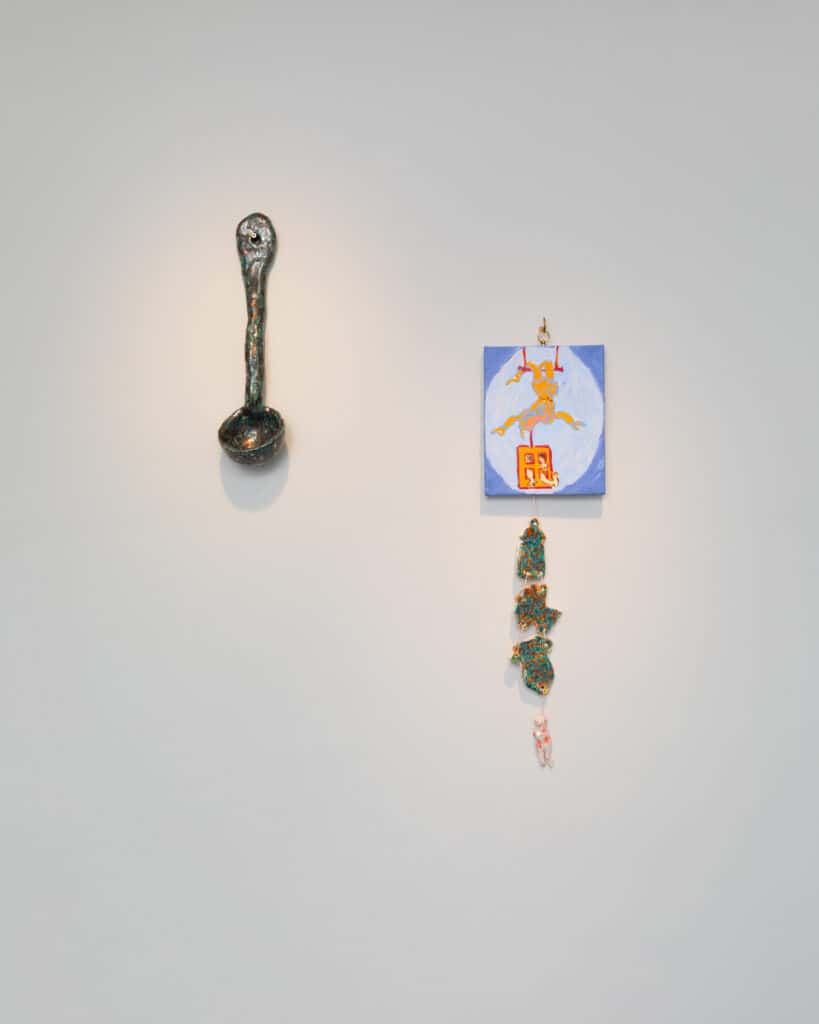
Your paintings are so energetic, enticing, and vibrant – they have a distinct tropical colour palette which you often attribute to your childhood spent in the volcanic Canary Islands. Can you expand on this as a point of inspiration?
It is the contrast of being brought up in two cultures, two climates, that of Tenerife and Andalusia, and London. As children we stood out here with our bright clothes, gold earrings and Flamenco dancing. The Canary Islands and Spain still represent this energy and colour for me. There is a Flamenco term known as Duende, which is when the performer lets go to such an extent that their spirit springs out and imbues the audience. This is what I search for in my paintings.
You portray the female in defiant guises across your practice creating an aura of empowerment. In what ways does your work engage with feminist practice?
When I think of feminist practice Judy Chicago’s Dinner Party, Mary Beth Edelson’s Selected Wall Collages at Tate, or the current exhibition Feminine Power at the British Museum come to mind. Like the work of these artists, my focus is to remind the viewer that women are inspirational, can have power, and that female goddess’ pre-Christianity were abundant and diverse. My research is concentrated on excavating stories about interesting women and reinstating them visually for the viewer to behold.
Your influences are in-depth and vast – from autobiographical events, fantastical symbols, sci-fi film, occulture, literature, esoteric pagan practices, and more. Tell us more about how you engage with these complex and esoteric themes.
In terms of autobiographical events, I see myself continuing a method of practice employed by artists such as Louise Bourgeois, Alina Szapocznikow and Paula Rego, who explored the female experience. On a practical level, when I begin a project, I’ll often start my research at the library. I also love watching sci fi films, programmes and reading novels.
For the exhibition FANCY A BITE? at STUDIO WEST, Notting Hill you are exhibiting with multi-disciplinary practitioner Nell Mitchell, painters Phoebe Boddy and Pippa El-Kadhi Brown, and sculptor Alice Johnson. How do you think your works sits in conversation with these other artists?
Pippa El-Kadhi Brown discusses the domestic nature of sharing meals within the home. While she explores the intimacy of this ritual, I looked at the banquet feast, set outside, on display. I think it’s interesting to see these different lenses, the habitual and the ceremonial aspects of sharing food and drink, within the same space.
What do you think it is about food and female artists? There seem to be a number of exciting young women creatives for whom the domestic, and food are prevalent topics. How is it explored in your own work?
There does seem to be a wonderful group of artists exploring food, sometimes humorous, and even grotesque. There was a particularly fun exhibition Let Them Eat fake! curated by Bad Art Presents which was an absolute feast for the eyes! In my work, food centres around mothering, in particular the experience of breastfeeding, its associations with the goddess Inanna and female creative power. And its flip side where the body can feel devoured and weighed down by nurturing. On a more joyful note, in this exhibition, I looked at the celebratory aspect of food and its symbol as an act of sharing, which ties in so well with the theme of Commensality that the show was built upon.
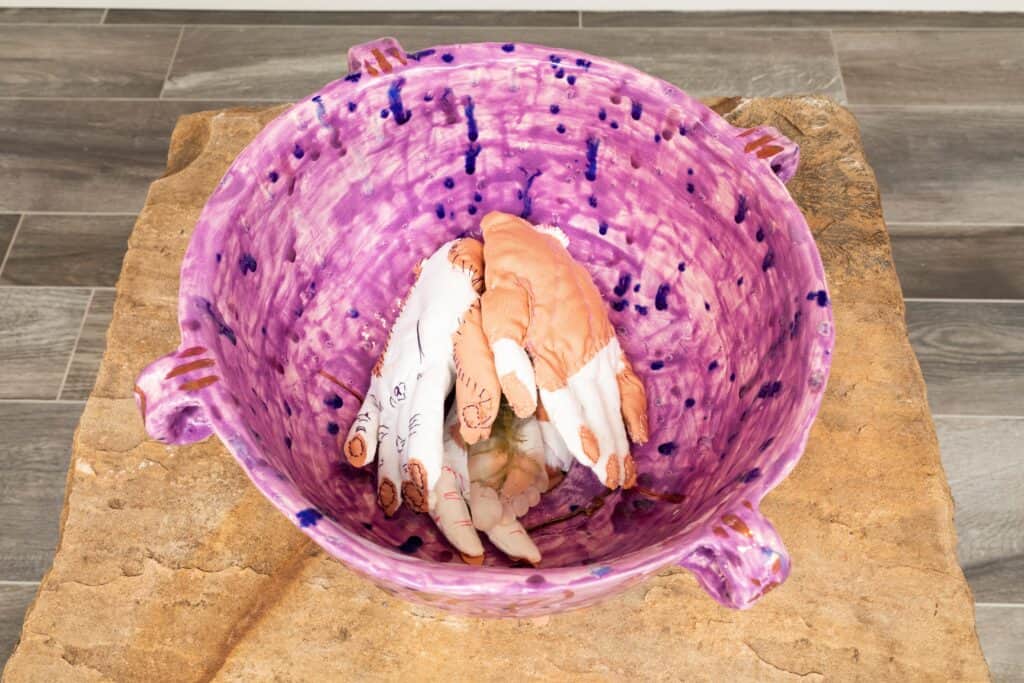
What can visitors expect from the exhibition? What are you showing at STUDIO WEST?
An installation of wallpaper, traditional Guanche shaped vessels (inspired by ceramics in the Canarian Museum of Archaeology), and paintings based on the Sola Busca ritual. It is about nurture; as I stitch together ceramic, painting and textiles, I think of Athena weaving the story of the gods in Charlotte Higgins Greek Myths.
How have you found the process of working on FANCY A BITE? and the recipe book that has been created collectively by the artists as part of the show?
The curators were very supportive of me doing an installation and trusting it would come together as a whole. The recipe book is a fantastic example of how you can activate the objects within a space. My ritual recipe of burying a pig in an underground fire oven, gives instructions on how to create a ceremonial banquet feast in open air, mirroring the outdoor ceremonial ritual portrayed in the wallpaper and paintings.
What are your favourite foods? What role does dining play in your life?
My favourite foods are those which can be shared in a group- tapas or pinchos where there is a grab and chat way of being. Apart from the fire pit rituals, we also like creating big stews and pies that can feed large groups of people. We always feel the impulse to feed guests, even if they are only popping in for a drink, there has to be cheese or cakes on offer!
Rafaela de Ascanio’s work is on show at Studio West until 6th July 2022 & Tristan Hoare until 8th July 2022.
About the artist
Rafaela de Ascanio (b.1986) lives and works in London. She completed her Fine Art Foundation at Central St Martins in 2006, then went on to study at The Courtauld Institute of Art, completing her MA in 2010. In 2019 Rafaela attended the Turps Banana Painting Programme. Recent solo exhibitions include Universal Yearnings (2021), Liliya Art Gallery in London. Duo shows include Back to Back (2021) at Bowes Parris Gallery in London, The Deccan Traps (2019) at Aindrea Contemporary in London, and The Body is a Blessed Juicy Fruit (2018) at Lamb in London. Recent group shows include Cracked (2021) at Tristan Hoare in London, Focus on the Female (2021) at Cynthia Corbett Gallery in London, Monster/Beauty: An Exploration of the Female/Femme Gaze (2020) at Lychee One in London, and Paintings On, And With Paper (2020) at Cob Gallery in London. In 2021 Rafaela received the Young Masters Emerging Artist Award
